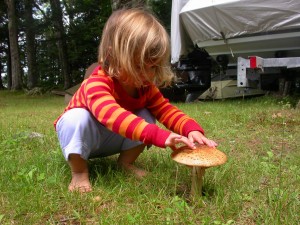The field and laboratory are places where problems are approached in real-time and where answers can be discovered, not just learned. Skills gained hands-on complement knowledge learned in the classroom to prepare students to solve problems and innovate. This is lately termed ‘experiential learning,’ and as long as we don’t ruin a great idea by overstructuring things, the future of teaching is going to be way more interactive than it is now. Working in a lab, for starters, students have the chance to design, implement and share projects in an interdisciplinary group and among the resource-rich scientific community at the University of Minnesota. Interested in working in the lab or on an undergraduate research opportunity program (UROP) project? Contact me.
Courses
PMB 3212/5212 Fungi: A Kingdom of Their Own (each Spring; 3 credits)
This new course will use a format of lecture, discussion, and field trips to provide undergraduate and graduate students with a solid foundation in the fungi, primarily through an environmental lens. Undergraduate and graduate students will learn the basics of fungi in three core sections: 1) Phylogeny, taxonomy, and diagnostics (Who are the fungi?); 2) Morphology and physiology (How do fungi work?); 3) Ecology and Biotechnology (What are fungal implications and applications?). Within each core section, there will be one class period devoted to a discussion of the environment, the role of fungi, and the human dimensions of conservation and management. This discussion will be used by the class to vote for an environmental theme used to frame writing assignments, one per unit. Using this theme, all students will create a ‘Fungus in Focus’ one-page ‘brief’ focused on this environmental issue. This is a creative way to connect ‘dots’ for students linking microbial processes to environment, in our case harnessing connections to fungi that often have visible characters (e.g. mushrooms) that make those connections easier for students. We will also go on two field trips, one to a mushroom cultivation facility, and one into the field in April, all depending on class size and weather.
As a ‘dual-listed’ course, the expectations for graduate students will not be for more work – it will be for different work. Undergraduate students will be assigned to do an ‘Environment Theme’ paper and ‘lightning’ presentation on the human dimensions of bioremediation. Bioremediation is the process of using organisms, in our case fungi, to detoxify or otherwise remediate environmental contamination. This seems like a noble cause, but as the students will explore, there are human dimensions that create a dilemma – bioremediation offers a valuable route to decrease pollution but also a justification to industry to create more, not less pollution, with the assumption that clean-up is reliable. This is called the ‘band aid’ effect by some, and ‘enabling science’ by others. Students will explore organismal, environmental, industry, regulatory and citizen perspectives in framing a bioremediation case study. Graduate students will be assigned a paper/presentation project requiring deeper synthesis in fungal research. Specifically, graduate students will use a ‘Question Framing’ project to create a knowledge gap in the scientific literature using two contrasting studies in a similar system, and then fill the gap with a logical, feasible design. They will present a longer ‘thunder’ presentation to pitch their logic and design as if going in front of a funding panel. This assignment has proven a useful process for graduate students in their first coursework-heavy years to simplify the literature searching they are inevitably doing for their own research. The outcome is a straightforward, logic-based white paper pitch that can successfully facilitate students in design phase.
